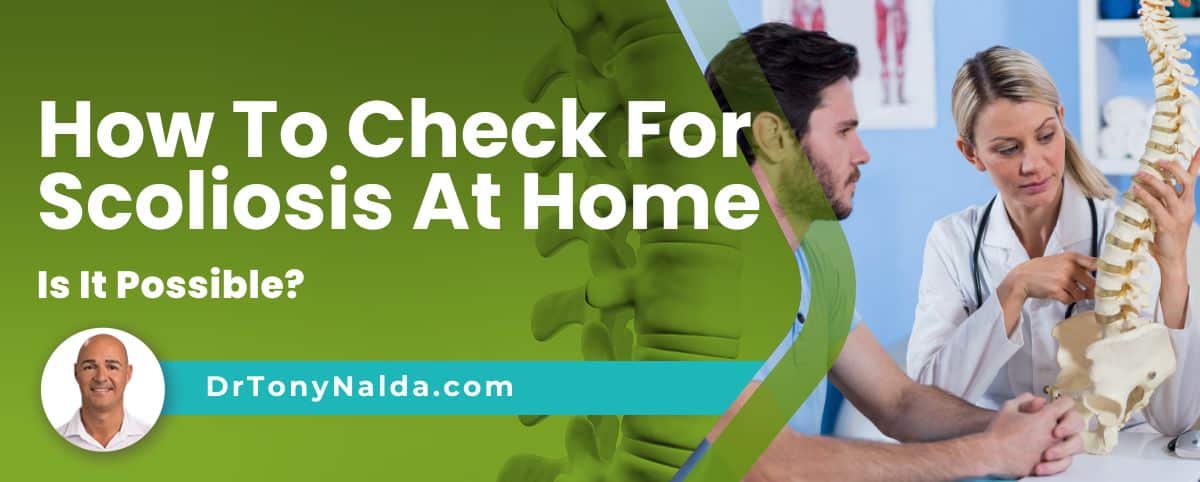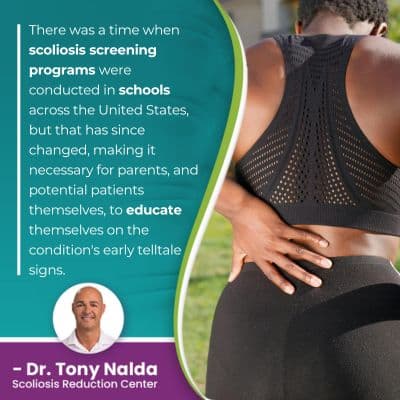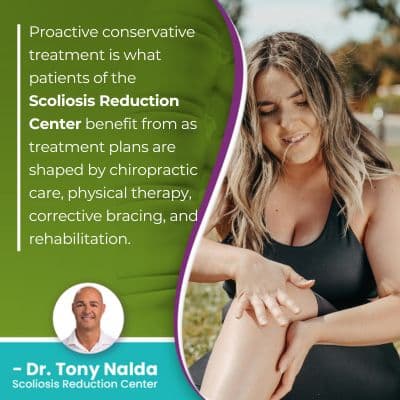How To Check For Scoliosis At Home: Is It Possible?

The effects of scoliosis can be widespread, and while some effects can be overt, others are subtle and require the trained eye of a scoliosis specialist to recognize. Scoliosis is a highly-variable condition ranging from mild to moderate and severe to very severe, and the more severe, the easier it can be to recognize the condition's effects.
The only way to officially reach a diagnosis of scoliosis is through a combined physical examination and X-ray results performed by a medical professional; however, being able to recognize the condition's early signs at home can lead to early detection.
While early detection doesn't guarantee treatment success, it increases its likelihood, so let's start with why.
Table of Contents
Early Detection Benefits
Scoliosis is a progressive condition, meaning its nature is to get worse over time, and a scoliosis diagnosis means an unnatural sideways curvature of the spine has developed that also twists.
As scoliosis progresses, the unhealthy spinal curve gets larger and the condition's effects tend to become more noticeable; in addition, the scoliosis gets harder to treat.
While there are never treatment guarantees, early detection and early intervention does increase the likelihood of treatment success.
As scoliosis progresses, the spine gets increasingly rigid, making it less responsive to treatment and making it difficult for some patients to perform certain therapeutic exercises as part of treatment.
It's far simpler to work towards correcting minor scoliosis than it is to approach severe scoliosis once it's been left to progress unimpeded.
So when scoliosis is diagnosed early in its progressive line, treatment can be started while the condition is still mild, when it's going to be at its most responsive, and this is why it can be so beneficial for people to know the condition's early signs to look for at home.
When it comes to children, the main condition effect involves postural changes, and scoliosis is most often diagnosed in children, although it does also affect adults.
The most prevalent type of scoliosis overall is adolescent idiopathic scoliosis, diagnosed between the ages of 10 and 18, so we'll focus on this type for our current purposes.
Adolescent Idiopathic Scoliosis Signs
The idiopathic designation means not clearly associated with a single-known cause; idiopathic scoliosis is instead thought to be multifactorial.
We don't know why idiopathic scoliosis develops initially, but we know what makes it progress: growth.
Adolescents are the most at risk for rapid-phase progression due to the stage of rapid growth and development they are in, and a rapid growth spurt can trigger rapid progression, making the condition more complex to treat.
 So knowing the early telltale signs of adolescent idiopathic scoliosis can help lead to early detection and treatment, and oftentimes, the first signs are uneven shoulders and hips.
So knowing the early telltale signs of adolescent idiopathic scoliosis can help lead to early detection and treatment, and oftentimes, the first signs are uneven shoulders and hips.
Additional postural changes to watch for include:
- The head uncentered over the torso
- An eye-line tilted
- Uneven shoulder blades
- The development of a rib cage arch
- Arms and legs that will hang at different lengths
As posture changes due to the disruption in the body's overall symmetry, movement can be impacted in gait, balance, and coordination, and these changes also become more overt alongside progression.
The focus of adolescent idiopathic scoliosis treatment is to achieve a significant curvature reduction and hold it there despite the constant progressive trigger of growth.
What Position is the Best for Checking Scoliosis?
There was a time when scoliosis screening programs were conducted in schools across the United States, but that has since changed, making it necessary for parents, and potential patients themselves, to educate themselves on the condition's early telltale signs.
The gold standard in scoliosis screening examinations is known as the Adam's forward bend test, and this involves standing straight and bending forward at the hips as if trying to touch the toes and with the back parallel to the floor.
During an Adam's forward bend test, the spine is highly visible, as are any related trunk asymmetries, and when combined with the use of a Scoliometer, the test can also indicate a patient's angle of trunk rotation (ATR).
When in a forward bend position, indicators of scoliosis can be detected and warrant the need for further testing, which would mean a scoliosis X-ray to confirm what's going on in and around the spine, a rotational component, and the patient's Cobb angle measurement.
So being in a forward bend is the best position to be in while having someone look at your spine from home; they can check if the spine looks unnaturally bent to the side, if the shoulders look uneven, the hips, and if any other asymmetries are present.
If a home examination has areas of concern, an appointment can be made with a medical professional for a scoliosis screening exam, and while scoliosis is more often diagnosed in children, the actual rate of scoliosis increases with age, and this is due to natural age-related spinal degeneration.
Checking for Adult Scoliosis
While scoliosis most often affects children, it is also diagnosed in adults.
While postural changes are the earliest warning signs of scoliosis in children, in adults, it's pain that brings the majority of my adult patients in for a diagnosis and treatment.
So the main sign of adult scoliosis is pain; scoliosis becomes a compressive condition once skeletal maturity has been reached, and this can include muscle pain, back pain, and or pain that radiates into the extremities due to nerve compression.
In young patients whose spines are still growing, the constant lengthening motion counteracts the compressive force of the unnatural spinal curve
The main type of scoliosis to affect adults is idiopathic scoliosis, and these are cases of adolescents who were undiagnosed and untreated during adolescence and didn't know they had scoliosis until it becomes compressive and painful in adulthood.
So knowing the signs to watch for during adolescence can mean avoiding an adult diagnosis in the future.
After idiopathic scoliosis, degenerative scoliosis is the next most common type to affect adults, and the signs of this are increasing postural changes, a prominent lean to one side, and disruptions to balance and movement due to the spine becoming increasingly unstable over time.
Proactive Treatment
 The benefits of early detection are only available to those who respond with a proactive treatment approach, and this means conservative treatment that integrates multiple scoliosis-specific treatment disciplines to impact conditions on every level.
The benefits of early detection are only available to those who respond with a proactive treatment approach, and this means conservative treatment that integrates multiple scoliosis-specific treatment disciplines to impact conditions on every level.
Proactive conservative treatment is what patients of the Scoliosis Reduction Center benefit from as treatment plans are shaped by chiropractic care, physical therapy, corrective bracing, and rehabilitation.
It's generally far more effective to proactively work towards preventing progression and increasing condition effects than it is to attempt to reverse them once they've developed.
Being proactive means working towards a curvature reduction on a structural level through chiropractic techniques and adjustments, increasing core strength and stabilization through physical therapy and the prescription of scoliosis-specific exercises.
Corrective bracing can be particularly effective on growing spines and can help by pushing the spine into a corrective position.
Rehabilitation is the continuous phase of treatment that can involve chiropractic care and home exercises.
Conclusion
So can you check for scoliosis at home, as in diagnose scoliosis at home: no, scoliosis needs assessment and an X-ray performed by a medical professional to be diagnosed.
There are a number of spinal conditions that cause a loss of its healthy curves, but scoliosis has some characteristics that set it apart from the rest; it's progressive, 3-dimensional, ranges widely in severity, affects all ages, and has multiple types that can develop.
What people can do is check for signs of scoliosis at home, and the best time to start is prior to a child's first pubescent growth spurt; this is when I can make the biggest impact with treatment.
Scoliosis progression is triggered by growth, so the more growth a child has yet to go through, the more potential progression they are facing, and this is why childhood scoliosis should always be taken seriously and treated proactively.
The best way to check for indicators of scoliosis at home is by standing in a forward bend position so the spine is highly visible, as are any additional trunk asymmetries.
If uneven shoulders and hips are detected, this warrants the need for further testing in the form of an assessment examination and a scoliosis X-ray.
As the leading spinal condition among school-aged children, scoliosis warrants awareness, and knowing the condition's early signs can help lead to early detection and get treatment started at the ideal time.
Dr. Tony Nalda
DOCTOR OF CHIROPRACTIC
After receiving an undergraduate degree in psychology and his Doctorate of Chiropractic from Life University, Dr. Nalda settled in Celebration, Florida and proceeded to build one of Central Florida’s most successful chiropractic clinics.
His experience with patients suffering from scoliosis, and the confusion and frustration they faced, led him to seek a specialty in scoliosis care. In 2006 he completed his Intensive Care Certification from CLEAR Institute, a leading scoliosis educational and certification center.
About Dr. Tony Nalda
 Ready to explore scoliosis treatment? Contact Us Now
Ready to explore scoliosis treatment? Contact Us Now





